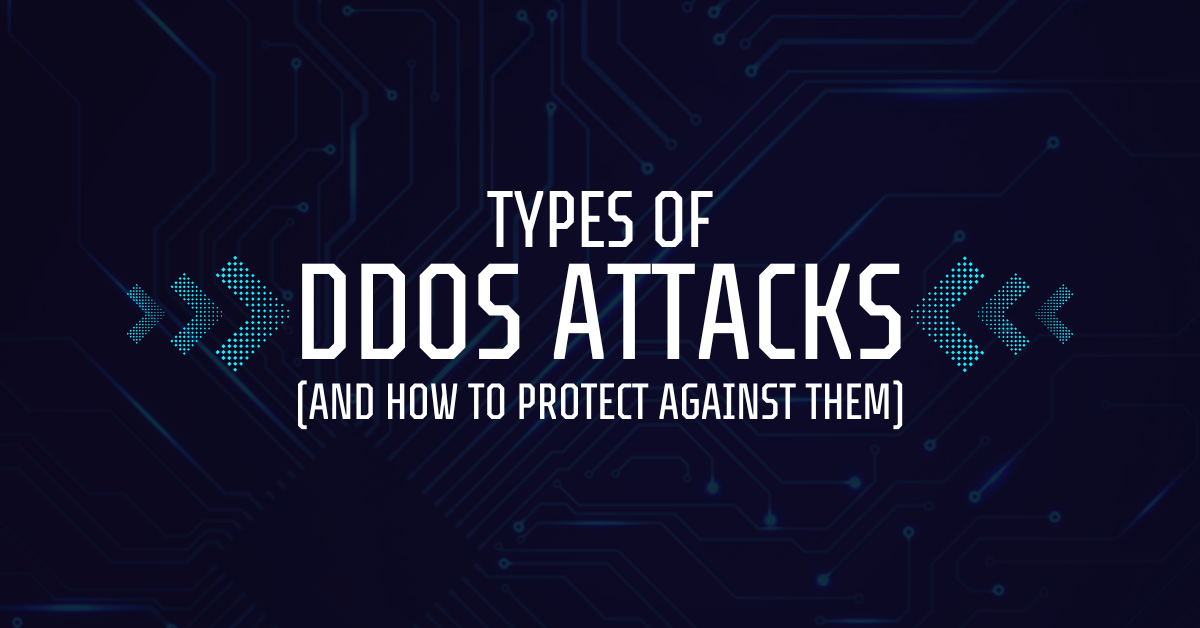The Main Types of DDoS Attacks (and How to Protect Against Them)

Of the various potential attack vectors that bad actors can utilize to disrupt business operations and frustrate services, distributed denial-of-service (DDoS) attacks are amongst the most common. With hundreds of thousands of DDoS attacks occurring around the globe each year, businesses are increasingly pressured to understand how attacks occur and what they can do to prevent them.
The first step toward effective DDoS protection is understanding what DDoS attacks are, how they work, and the different strategies they use. Let’s explore the most common types of attacks, how they manifest, and how organizations can use modern cybersecurity technology to keep themselves safe
What is a DDoS Attack?
A distributed denial-of-service attack aims to interrupt the flow of traffic to a server by flooding the network with botted traffic. Attackers use a network of hacked or possessed computers, mobile phones, and Internet of Things (IoT) devices to send a spike of high-volume traffic to a server, overloading the system and preventing actual human traffic from reaching the server.
DDoS attackers typically use malware to infect computer systems around the world. Once infected, they can activate the devices remotely, triggering them to access a server simultaneously. As each device is legitimate, it becomes extremely difficult for a network admin to determine which sources of traffic are coming from the bot network and which are real traffic attempting to connect to a server.
Without an easy way of defining real traffic from botted traffic, the attack essentially disables access to a server by flooding its network with traffic. Depending on the server architecture, a DDoS attack could completely disable a site or slow it down to a point where it becomes impossible to use.
What a DDoS Attack Looks Like
DDoS may initially be hard to spot as it can resemble a spike in traffic. As with any site and server, a dramatic increase in traffic will lead to low responsiveness and other issues in performance. It’s only when this sudden spike is maintained for an extended period of time that network admins are able to definitively say that they’re facing a DDoS attack.
When examining the traffic that’s engaging with a site, there are a few signs that typically signal a DDoS attack:
- Similar Network Traffic: Many DDoS attackers will have devices in a similar location or will run their commands through a specific web browser. Lots of connections that spring up with similar markers may indicate a DDoS attack.
- Unexplainable Surges in Traffic: Some businesses will expect their traffic to surge from time to time. An eCommerce store, for example, might receive a great deal of traffic on its launch day or during a flash sale. However, if a company has no reason to suddenly incur a spike in activity, it could be the beginning of a DDoS attack.
- Single-Page Attacks: Traffic to a website comes in from any indexed page. Businesses might receive clicks from different blogs, service pages, or directly to their homepage. When traffic seems to only connect to one endpoint, like your homepage, it may come from bots.
Across the globe, DDoS attacks are a common and rising concern. In 2023, companies expected DDoS attacks to increase by around 25%, demonstrating how prominent this threat has become.
The Main Types of DDoS Attacks
While DDoS attacks all aim to overload the target server with traffic, they don’t all target the same part of the server or use the same strategies. Different formats of DDoS attacks can exhaust different server resources or occupy distinct parts of the network.
There are three common types of DDoS attacks:
1. Application Layer Attack:
An application layer DDoS attack targets layer 7 of the OSI model. This attack generates many HTTP requests to load certain pages. The server will need to search for the relevant information, run queries, and deliver the page, which can create a large processing overhead and overwhelm the system.
2. Volumetric-Based Attack:
A volumetric attack is the oldest and most prominent form of DDoS attack. This form of DDoS singularly goes for volume, aiming to overwhelm the server’s bandwidth by generating requests for the server to respond to. Bad actors can use DNS amplification to send many small DNS requests, forcing the server to generate large responses and occupy its resources.
3. Network Protocol Attack:
A network protocol attack, also known as a Layer 3 and 4 DDoS attack, aims to exploit inherent vulnerabilities in network equipment. One common type of network protocol attack is SYN flooding, where a bad actor sends a huge number of initial connection requests without then completing the handshake. This strategy exhausts the network’s resources and slows the server.
Understanding the common signals of each of these types of DDoS attacks allows cybersecurity experts and network admins to identify and defend against the attack as quickly as possible.
Managing the DDoS Threat
The past two decades have seen a dramatic rise in the number of IoT devices around the world. With everything from smart TVs to digital refrigerators now having an internet connection and often lacking basic security defenses, bad actors have thousands of devices at their fingertips.
As the threat of DDoS attacks continues to rise, businesses are increasingly turning to modern DDoS protection solutions to keep them safe. DDoS mitigation tools and strategies help companies detect abnormal surges in traffic, redirect it away from its target, and then filter it out of the system.
While the potential risk a DDoS attack poses has increased, the tools and systems businesses have to combat this risk are constantly improving. Especially with the incorporation of advanced analytical services to prevent future attacks, businesses have never had more options when it comes to mitigating DDoS attacks.







